Introduction and Background
A common malady that ALL E500Es (and 400E/E420s with rear SLS) suffer sooner or later, is a distinct and loud "clunking" at the rear, when the car travels over certain bumps. Not ALL bumps, but certain sharp bumps such as curbs, large pavement cracks/potholes and expansion joints, and other significant road irregularities. The rear suspension typically does NOT "clunk" when driving down the road, over typical uneven road surfaces.
The cause of this problem are worn lower bushings on the rear SLS hydraulic struts. These bushings wear with age and mileage, and this leads to abnormal flexing of the bushing and eventually, essentially metal-to-metal contact as the inside metal portion of the bush contacts the outside of the bush over these significant bumps.
For some reason, the passenger side (right side) strut seems to be the first one to go bad, the majority of the time. However, when one fails, even if the other one looks to be usable, it is just a matter of a short time until the "good" bushing also fails.
Earlier this year, my 1994 E500 with 131,000 miles on the odometer started suffering this malady. It was immediately apparent as to what the problem was, based on numerous descriptions of the problem and threads posted here on the forum about it.
Job Overview
This job entails replacement of the rear struts. These struts are available through your local MB dealer or mail-order establishment, and are also available as aftermarket units solely made by the part's OEM, Sachs.
To accomplish the job, the self-leveling hydraulic system needs to be bled, and then the struts are removed at their upper mounts (in the trunk) and their lower mounts (at the lower control arms). The time required for the job for a first-time mechanic would be around 2.5-3 hours, and only simple hand tools are required for this job.
A good procedure for this job can be found in the factory manual, which can be either augmented or completely supplanted by this HOW-TO article.
I would call this a "light-moderate" DIY job, probably a 3.5 on a scale of 1-10 for the DIY shade-tree mechanic.
Job Requirements
The following parts are required to do this job. A few "optional" parts are also listed below, which would be prudent & highly recommended to replace at the same time, as no incremental labour would be required to do so.
The following tools are required. No esoteric tools are needed for this job, and it can generally be done with a normal home mechanic's assortment of tools.
Job Preparation
Before you get started, it's a good idea to spread cardboard (I used a mover's blanket) beneath your work area under the rear of the car and rear wheel area that you are working on to catch dripping hydraulic oil.
Park the vehicle on a level surface and use your lug bolt wrench to loosen the lug bolts on both rear wheels, although you will only be working on one side of the vehicle at a time. Place your chocks under the FRONT wheels, with the car in Park, and the rear parking brake OFF.


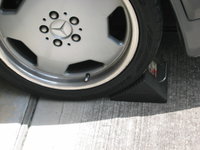
Getting Started
The first thing you need to do after stabilizing the vehicle, is to jack up one side of the vehicle. I chose to raise the passenger side first, so I jacked it up with the floor jack at the rear rubber jacking point, and I set the jack at that level with the rear wheel about 6 inches off the ground. Then I placed a jack-stand under the rear of the car near the jack as an additional safety measure.
After you do this, you need to locate the rear SLS hydraulic control valve. It is located in the center rear of the car, just behind the rear differential and near the rear flex disc. Here is a photo of the unmolested rear SLS control valve.

It's a good idea to give the outside of the valve a good shot of brake cleaner, which you can "catch" the spills with a rag. This will help clean it off a bit and make things easier to identify. The next thing you need to do is to locate the pressure relief screw, which is a 10mm bolt that is immediately adjacent to the lever on the front of the valve. You can see its head sticking out immediately to the right of the lever in the above photo - it's the bright bolt head.
Take your 10mm combination wrench, and having your jar handy to catch hydraulic fluid (you need about a quart-size jar) CAREFULLY and SLOWLY open the pressure relief screw with a counter-clockwise motion. You will immediately see hydraulic fluid start to dribble down from the screw where it enters the valve's housing. With your jar handy to catch drips, keep turning the screw counter-clockwise and opening it up further. You should see a stronger flow of foamy oil dripping down into the jar, and probably will hear a hissing sound as the pressure begins to release.
MB procedure says that you can and should use a hose around the bleed screw to direct the fluid into the jar, but it's fairly easy to just let the fluid drip down in a steady stream into the jar. You'll let about 3/4 of a quart (liter) drain before the pressure subsides.
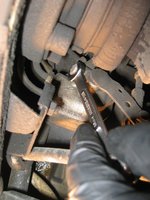
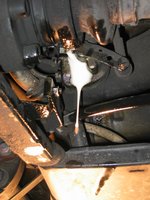
After the fluid drains and the escaping pressure subsides, tighten the bleeder screw to the factory torque of 14 Nm.
Doing the drain and pressure release this way will take about a half-hour to accomplish. You can just set your wide-mouth jar under the valve and let the fluid drip-drip-drip into the jar on its own while you get some other preparatory jobs done.
The next prep job you can do is to remove the inner side trunk linings on both sides of the car. This will allow you to get at the top strut mounts when the time comes, which will be pretty soon.
Another "prep" job you should do is to get under the car, and remove the two plastic lower control arm covers. These are each held on by two 10mm short screws, which you can use a 10mm socket (deep or shallow) to remove. The two covers pull right off, straight downward after releasing the elongated tabs on the sides that hook onto the top of the control arm.

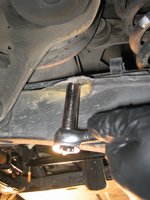


Here's a shot of the hydraulic line that goes from the hydraulic sphere to the top of the rear SLS strut, just for giggles. You're going to disconnect this line at the strut later on.

After removing the trunk lining, here is what the exposed upper strut mounts look like.


Wait for the hydraulic fluid to stop draining, remove the jack stand and use the hydraulic jack to LOWER THE CAR to the ground. This is IMPORTANT given the next step.
After lowering the car to the ground, so that the tire is touching the ground and the weight of the car is on it, you can begin to remove the upper strut mount inside the trunk. There are two 17mm nuts that hold the top of the strut to the car's body structure. Use your two 17mm combination wrenches to loosen the top nut (counterhold the lower nut with your second wrench as shown), and remove it with your fingers. Then loosen the bottom 17mm nut, and use your deep 17mm socket (or your wrench if you want to go slower) to remove it. Then remove the rubber top bushing and its large washer.


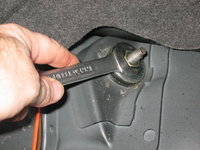




After you've removed the strut's top mount inside the trunk, use your floor jack and jack stand to raise the car again, and stabilize it with the jack stand. Remove the lug bolts that you already loosened, and remove the wheel and tire from the car and set it aside. This will give you working room to access the strut.

After removing the wheel, this is what you should see. The threaded upper part of the strut should have released from the body of the car and traveled downward as you jacked up that side of the car.


Give the banjo bolt of the hydraulic hose connection at the top of the strut a shot of brake cleaner, to clean it off.

Then, using your 17mm combo wrench, and a handy rag to catch pressure and fluid that will released when you loosen the banjo bolt, CAREFULLY loosen the banjo bolt. Catch the fluid/pressure with the rag. It will subside after a couple of seconds.


Loosen the banjo bolt a bit more until you can remove it with your fingers. Set it and its two copper washers aside. You will be replacing these washers with new ones.


Here's what the strut looks like with the hydraulic line removed.
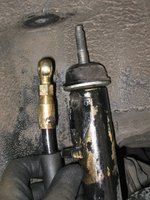
Next, it's time to turn your attention to the lower nut and bolt combo that connect the bottom of the SLS strut to the lower control arm. There is only a single bolt that holds the strut to the LCA (the 124 wagons have dual bolts). Use a 17mm combo wrench and a 17mm socket (one being a counter-hold for leverage) to loosen the very tight nut, and loosen and remove it with your fingers. It should have a single washer on each side of the LCA.




Then, carefully lift the strut out of the wheel well of the car. Pour its remaining oil (probably 1-2 oz) out of the upper hole into your hydraulic oil receptacle/jar. Drain it carefully and completely so it doesn't leak after you put it aside.
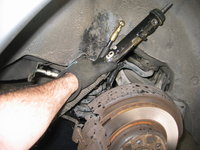

Remove the rubber lower bushing and washer from the top of the old strut.

To be continued in next post ....

A common malady that ALL E500Es (and 400E/E420s with rear SLS) suffer sooner or later, is a distinct and loud "clunking" at the rear, when the car travels over certain bumps. Not ALL bumps, but certain sharp bumps such as curbs, large pavement cracks/potholes and expansion joints, and other significant road irregularities. The rear suspension typically does NOT "clunk" when driving down the road, over typical uneven road surfaces.
The cause of this problem are worn lower bushings on the rear SLS hydraulic struts. These bushings wear with age and mileage, and this leads to abnormal flexing of the bushing and eventually, essentially metal-to-metal contact as the inside metal portion of the bush contacts the outside of the bush over these significant bumps.
For some reason, the passenger side (right side) strut seems to be the first one to go bad, the majority of the time. However, when one fails, even if the other one looks to be usable, it is just a matter of a short time until the "good" bushing also fails.
Earlier this year, my 1994 E500 with 131,000 miles on the odometer started suffering this malady. It was immediately apparent as to what the problem was, based on numerous descriptions of the problem and threads posted here on the forum about it.
Job Overview
This job entails replacement of the rear struts. These struts are available through your local MB dealer or mail-order establishment, and are also available as aftermarket units solely made by the part's OEM, Sachs.
To accomplish the job, the self-leveling hydraulic system needs to be bled, and then the struts are removed at their upper mounts (in the trunk) and their lower mounts (at the lower control arms). The time required for the job for a first-time mechanic would be around 2.5-3 hours, and only simple hand tools are required for this job.
A good procedure for this job can be found in the factory manual, which can be either augmented or completely supplanted by this HOW-TO article.
I would call this a "light-moderate" DIY job, probably a 3.5 on a scale of 1-10 for the DIY shade-tree mechanic.
Job Requirements
The following parts are required to do this job. A few "optional" parts are also listed below, which would be prudent & highly recommended to replace at the same time, as no incremental labour would be required to do so.
- Sachs or MB rear SLS hydropneumatic strut (two required): MB part number 124-320-42-13 - NLA as of late 2023
- Four copper O-rings: MB part number 007603-012102
- Two self-locking lower control arm nuts: MB part number 910113-010003
OPTIONAL:Two upper strut rubber bushings: MB part number 201-326-18-68- NLA as a separate part- OPTIONAL: Two lower strut rubber bushings: MB part number 124-326-03-68
- OPTIONAL: Two hardware kits, which include upper & lower rubber bushings: MB part number 124-320-03-56 - only way to get the NLA rubber bushing above (201-326-18-68)
The following tools are required. No esoteric tools are needed for this job, and it can generally be done with a normal home mechanic's assortment of tools.
- Hydraulic floor jack
- Lug bolt wrench
- Wheel chocks (for safety)
- One jack stand (for safety)
- Small or medium flat-blade screwdriver
- 1/4" and 3/8" ratchets
- 17mm 3/8" socket (shallow required; deep and shallow preferred)
- 10mm 1/4" socket
- 10mm combination wrench (box + open-end)
- 17mm combination wrench (box + open-end)
- 1/2 can brake cleaner
- Rags and/or shop towels
- Jar to collect hydraulic oil
- 1 liter SLS hydraulic oil (use correct spec oil) - optional
- Medium-size funnel
Job Preparation
Before you get started, it's a good idea to spread cardboard (I used a mover's blanket) beneath your work area under the rear of the car and rear wheel area that you are working on to catch dripping hydraulic oil.
Park the vehicle on a level surface and use your lug bolt wrench to loosen the lug bolts on both rear wheels, although you will only be working on one side of the vehicle at a time. Place your chocks under the FRONT wheels, with the car in Park, and the rear parking brake OFF.



Getting Started
The first thing you need to do after stabilizing the vehicle, is to jack up one side of the vehicle. I chose to raise the passenger side first, so I jacked it up with the floor jack at the rear rubber jacking point, and I set the jack at that level with the rear wheel about 6 inches off the ground. Then I placed a jack-stand under the rear of the car near the jack as an additional safety measure.
After you do this, you need to locate the rear SLS hydraulic control valve. It is located in the center rear of the car, just behind the rear differential and near the rear flex disc. Here is a photo of the unmolested rear SLS control valve.

It's a good idea to give the outside of the valve a good shot of brake cleaner, which you can "catch" the spills with a rag. This will help clean it off a bit and make things easier to identify. The next thing you need to do is to locate the pressure relief screw, which is a 10mm bolt that is immediately adjacent to the lever on the front of the valve. You can see its head sticking out immediately to the right of the lever in the above photo - it's the bright bolt head.
Take your 10mm combination wrench, and having your jar handy to catch hydraulic fluid (you need about a quart-size jar) CAREFULLY and SLOWLY open the pressure relief screw with a counter-clockwise motion. You will immediately see hydraulic fluid start to dribble down from the screw where it enters the valve's housing. With your jar handy to catch drips, keep turning the screw counter-clockwise and opening it up further. You should see a stronger flow of foamy oil dripping down into the jar, and probably will hear a hissing sound as the pressure begins to release.
MB procedure says that you can and should use a hose around the bleed screw to direct the fluid into the jar, but it's fairly easy to just let the fluid drip down in a steady stream into the jar. You'll let about 3/4 of a quart (liter) drain before the pressure subsides.


After the fluid drains and the escaping pressure subsides, tighten the bleeder screw to the factory torque of 14 Nm.
Doing the drain and pressure release this way will take about a half-hour to accomplish. You can just set your wide-mouth jar under the valve and let the fluid drip-drip-drip into the jar on its own while you get some other preparatory jobs done.
The next prep job you can do is to remove the inner side trunk linings on both sides of the car. This will allow you to get at the top strut mounts when the time comes, which will be pretty soon.
Another "prep" job you should do is to get under the car, and remove the two plastic lower control arm covers. These are each held on by two 10mm short screws, which you can use a 10mm socket (deep or shallow) to remove. The two covers pull right off, straight downward after releasing the elongated tabs on the sides that hook onto the top of the control arm.




Here's a shot of the hydraulic line that goes from the hydraulic sphere to the top of the rear SLS strut, just for giggles. You're going to disconnect this line at the strut later on.

After removing the trunk lining, here is what the exposed upper strut mounts look like.


Wait for the hydraulic fluid to stop draining, remove the jack stand and use the hydraulic jack to LOWER THE CAR to the ground. This is IMPORTANT given the next step.
After lowering the car to the ground, so that the tire is touching the ground and the weight of the car is on it, you can begin to remove the upper strut mount inside the trunk. There are two 17mm nuts that hold the top of the strut to the car's body structure. Use your two 17mm combination wrenches to loosen the top nut (counterhold the lower nut with your second wrench as shown), and remove it with your fingers. Then loosen the bottom 17mm nut, and use your deep 17mm socket (or your wrench if you want to go slower) to remove it. Then remove the rubber top bushing and its large washer.







After you've removed the strut's top mount inside the trunk, use your floor jack and jack stand to raise the car again, and stabilize it with the jack stand. Remove the lug bolts that you already loosened, and remove the wheel and tire from the car and set it aside. This will give you working room to access the strut.

After removing the wheel, this is what you should see. The threaded upper part of the strut should have released from the body of the car and traveled downward as you jacked up that side of the car.


Give the banjo bolt of the hydraulic hose connection at the top of the strut a shot of brake cleaner, to clean it off.

Then, using your 17mm combo wrench, and a handy rag to catch pressure and fluid that will released when you loosen the banjo bolt, CAREFULLY loosen the banjo bolt. Catch the fluid/pressure with the rag. It will subside after a couple of seconds.


Loosen the banjo bolt a bit more until you can remove it with your fingers. Set it and its two copper washers aside. You will be replacing these washers with new ones.


Here's what the strut looks like with the hydraulic line removed.

Next, it's time to turn your attention to the lower nut and bolt combo that connect the bottom of the SLS strut to the lower control arm. There is only a single bolt that holds the strut to the LCA (the 124 wagons have dual bolts). Use a 17mm combo wrench and a 17mm socket (one being a counter-hold for leverage) to loosen the very tight nut, and loosen and remove it with your fingers. It should have a single washer on each side of the LCA.




Then, carefully lift the strut out of the wheel well of the car. Pour its remaining oil (probably 1-2 oz) out of the upper hole into your hydraulic oil receptacle/jar. Drain it carefully and completely so it doesn't leak after you put it aside.


Remove the rubber lower bushing and washer from the top of the old strut.

To be continued in next post ....

Last edited by a moderator:


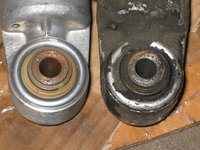


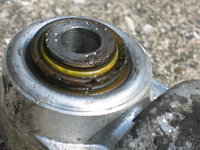











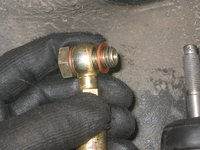


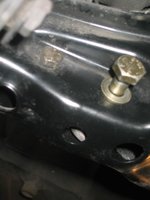
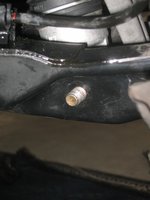
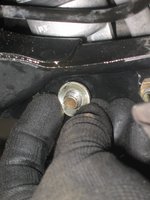


![[500Eboard] IMG_6962.JPG [500Eboard] IMG_6962.JPG](https://www.500eboard.co/forums/data/attachments/142/142337-c8ccf4fa26a07e96f25c7fbe0a033ca3.jpg?hash=yMz0-iagfp)








